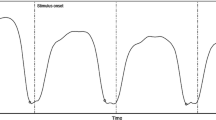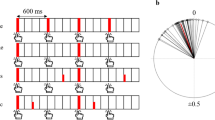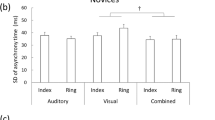Abstract
Synchronization of finger taps with periodically flashing visual stimuli is known to be much more variable than synchronization with an auditory metronome. When one of these rhythms is the synchronization target and the other serves as a distracter at various temporal offsets, strong auditory dominance is observed. However, it has recently been shown that visuomotor synchronization improves substantially with moving stimuli such as a continuously bouncing ball. The present study pitted a bouncing ball against an auditory metronome in a target–distracter synchronization paradigm, with the participants being auditory experts (musicians) and visual experts (video gamers and ball players). Synchronization was still less variable with auditory than with visual target stimuli in both groups. For musicians, auditory stimuli tended to be more distracting than visual stimuli, whereas the opposite was the case for the visual experts. Overall, there was no main effect of distracter modality. Thus, a distracting spatiotemporal visual rhythm can be as effective as a distracting auditory rhythm in its capacity to perturb synchronous movement, but its effectiveness also depends on modality-specific expertise.


Similar content being viewed by others
Notes
Participants’ accuracy in those reports was considered satisfactory (92.3 % correct on average for musicians, 95.5 % correct for visual experts). One musician forgot to report the numbers but affirmed that she had watched the videos at all times; her data were retained.
An approximation to the linear standard deviation (SD) can be obtained by first calculating the circular standard deviation CSD = sqrt(2 × CV) (Fisher, 1993, p. 33) and then, since we had previously calculated the linear SD for the nine Yale musicians, determining the exact relationship between CSD and SD by linear regression of the mean values of these participants. The equation turned out to be SD = 98.36 × CSD – 0.45, R 2 = 0.999. According to that formula, CVs of 0.02, 0.03, and 0.04 correspond to SDs of 19.2, 23.6, and 27.4 ms, respectively.
It could be argued that the mean relative asynchrony for the 300 ms distracter lead/lag (this data point being duplicated at −300 and +300 ms in the figure) is a better reference because distracter effects should be minimal at the separation of half a cycle. With that reference, the distracter effects appear more nearly symmetric, but then it would seem that visual distracters exerted an effect at the zero lag, making taps occur later than they otherwise would. A possible reason for this could be that the point of subjective simultaneity of tones and ball bounces actually corresponded to a slight lead of the ball bounce, so that the bounces were perceived as lagging the tones when they were physically simultaneous (cf. Arrighi, Alais, & Burr, 2005, 2006; Petrini et al., 2009). A related possibility is that the real mean asynchrony (which we could not assess because of the video delays) was less negative (or more positive) for unimodal bounces than for unimodal tones, so the asynchrony shifted in the positive direction when the two stimuli occurred simultaneously. However, in the Iversen et al. (2012) study, the asynchrony for the bouncing ball was considerably more negative than for tones: −75 ms versus −8 ms.
References
Alais, D., & Burr, D. (2004). The ventriloquist effect results from near-optimal bimodal integration. Current Biology, 14, 257–262.
Arrighi, R., Alais, D., & Burr, D. (2005). Neural latencies do not explain the auditory and audio-visual flash-lag effect. Vision Research, 45, 2917–2925.
Arrighi, R., Alais, D., & Burr, D. (2006). Perceptual synchrony of audiovisual streams for natural and artificial motion sequences. Journal of Vision, 6, 260–268.
Bermant, R. I., & Welch, R. B. (1976). Effect of degree of separation of visual-auditory stimulus and eye position upon spatial interaction of vision and audition. Perceptual and Motor Skills, 43, 487–493.
Bertelson, P., & Aschersleben, G. (1998). Automatic visual bias of perceived auditory location. Psychonomic Bulletin and Review, 5, 482–489.
Bertelson, P., & Radeau, M. (1981). Cross-modal bias and perceptual fusion with auditory-visual spatial discordance. Perception and Psychophysics, 29, 578–584.
Bootsma, R. J., & van Wieringen, P. C. W. (1990). Timing an attacking forehand drive in table tennis. Journal of Experimental Psychology: Human Perception and Performance, 16, 21–29.
Burr, D., Banks, M. S., & Morrone, M. C. (2009). Auditory dominance over vision in perception of interval duration. Experimental Brain Research, 198, 49–57.
Chen, Y., Repp, B. H., & Patel, A. D. (2002). Spectral decomposition of variability in synchronization and continuation tapping: comparisons between auditory and visual pacing and feedback conditions. Human Movement Science, 21, 515–532.
Elliott, M. T., Wing, A. M., & Welchman, A. E. (2010). Multisensory cues improve sensorimotor synchronisation. European Journal of Neuroscience, 31, 1–8.
Elliott, M. T., Wing, A. M., & Welchman, A. E. (2011). The effect of ageing on multisensory integration for the control of movement timing. Experimental Brain Research, 213, 291–298.
Ernst, M., & Banks, M. (2001). Humans integrate visual and haptic information in a statistically optimal fashion. Nature, 415, 429–433.
Fendrich, R., & Corballis, P. (2001). The temporal cross-capture of audition and vision. Attention, Perception & Psychophysics, 1, 719–725.
Fisher, N. I. (1993). Statistical analysis of circular data. Cambridge, UK: Cambridge University Press.
Fraisse, P. (1948). Rythmes auditifs et rythmes visuels (Visual and auditory rhythms). L’Anneé Psychologique, 49, 21–41.
Hove, M. J., Fairhurst, M. T., Kotz, S. A., & Keller, P. E. (in preparation). Synchronizing with auditory and visual rhythms: a reassessment of modality differences with fMRI.
Hove, M. J., & Keller, P. E. (2010). Spatiotemporal relations and movement trajectories in visuomotor synchronization. Music Perception, 28, 15–26.
Hove, M. J., Spivey, M. J., & Krumhansl, C. L. (2010). Compatibility of motion facilitates visuomotor synchronization. Journal of Experimental Psychology: Human Perception and Performance, 36, 1525–1534.
Iversen, J. R., Patel, A. D., Nicodemus, B., & Emmorey, K. (2012). Synchronization to auditory and visual rhythms in hearing and deaf individuals. Manuscript submitted for publication.
Kato, M., & Konishi, Y. (2006). Auditory dominance in the error correction process: a synchronized tapping study. Brain Research, 1084, 115–122.
Kolers, P. A., & Brewster, J. M. (1985). Rhythms and responses. Journal of Experimental Psychology: Human Perception and Performance, 11, 150–167.
Körding, K. P., & Wolpert, D. M. (2004). Bayesian integration in sensorimotor learning. Acta Psychologica, 133, 28–37.
Krause, V., Pollok, B., & Schnitzler, A. (2010). Perception in action: The impact of sensory information on sensorimotor synchronization in musicians and non-musicians. Acta Psychologica, 133, 28–37.
McBeath, M. K., Shaffer, D. M., & Kaiser, M. K. (1996). On catching fly balls. Science, 273, 256–259.
Morein-Zamir, S., Soto-Faraco, S., & Kingstone, A. (2003). Auditory capture of vision: examining temporal ventriloquism. Cognitive Brain Research, 17, 154–163.
Patel, A. D., Iversen, J. R., Chen, Y., & Repp, B. H. (2005). The influence of metricality and modality on synchronization with a beat. Experimental Brain Research, 163, 226–238.
Petrini, K., Dahl, S., Roccesso, D., Waadeland, C. H., Avanzini, F., Puce, A., et al. (2009). Multisensory integration of drumming actions: Musical expertise affects perceived audiovisual asynchrony. Experimental Brain Research, 198, 339–352.
Repp, B. H. (2003a). Phase attraction in sensorimotor synchronization with auditory sequences: Effects of single and periodic distractors on synchronization accuracy. Journal of Experimental Psychology: Human Perception and Performance, 29, 290–309.
Repp, B. H. (2003b). Rate limits in sensorimotor synchronization with auditory and visual sequences: The synchronization threshold and the benefits and costs of interval subdivision. Journal of Motor Behavior, 35, 355–370.
Repp, B. H. (2004). On the nature of phase attraction in sensorimotor synchronization with interleaved auditory sequences. Human Movement Science, 23, 389–413.
Repp, B. H., & Penel, A. (2002). Auditory domination in temporal processing: New evidence from synchronization with simulataneous visual and auditory sequences. Journal of Experimental Psychology: Human Perception and Performance, 28, 1085–1099.
Repp, B. H., & Penel, A. (2004). Rhythmic movement is attracted more strongly to auditory than visual rhythms. Psychological Research, 68, 252–270.
Tresilian, J. R. (1994). Perceptual and motor processes in interceptive timing. Human Movement Science, 13, 335–373.
van Beers, R., Sittig, A., & Gon, J. (1999). Integration of proprioceptive and visual position-information: an experimentally supported model. Journal of Neurophysiology, 81, 1355–1364.
Vroomen, J., Bertelson, P., & de Gelder, B. (2001). The ventriloquist effect does not depend on the direction of automatic visual attention. Perception and Psychophysics, 73, 651–659.
Wada, Y., Kitagawa, N., & Noguchi, K. (2003). Audio-visual integration in temporal perception. International Journal of Psychophysiology, 50, 117–124.
Warren, D., Welch, R., & McCarthy, T. (1981). The role of visual-auditory compellingness in the ventriloquist effect: Implications for transitivity among the spatial senses. Perception and Psychophysics, 30, 557–564.
Welch, R., & Warren, D. (1980). Immediate perceptual response to intersensory discrepancy. Psychological Bulletin, 88, 638–667.
Wing, A., Doumas, M., & Welchman, A. E. (2010). Combining multisensory temporal information for movement synchronisation. Experimental Brain Research, 200, 277–282.
Acknowledgments
This research was supported by National Science Foundation Grant BCS-0924206 to BHR and by the Max Planck Society. The authors are grateful to Yi-Huang Su for helpful comments on the manuscript
Author information
Authors and Affiliations
Corresponding author
Rights and permissions
About this article
Cite this article
Hove, M.J., Iversen, J.R., Zhang, A. et al. Synchronization with competing visual and auditory rhythms: bouncing ball meets metronome. Psychological Research 77, 388–398 (2013). https://doi.org/10.1007/s00426-012-0441-0
Received:
Accepted:
Published:
Issue Date:
DOI: https://doi.org/10.1007/s00426-012-0441-0




